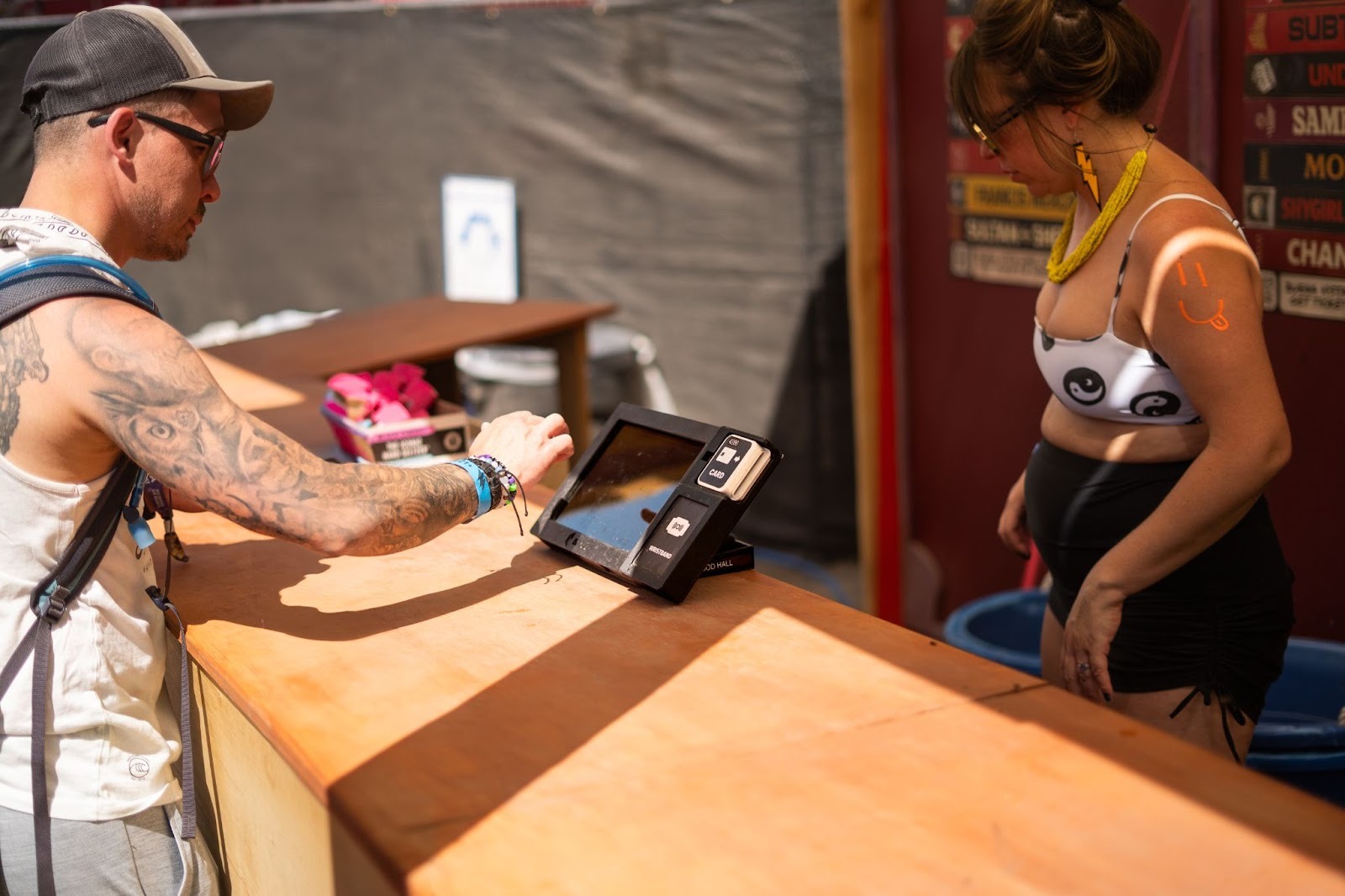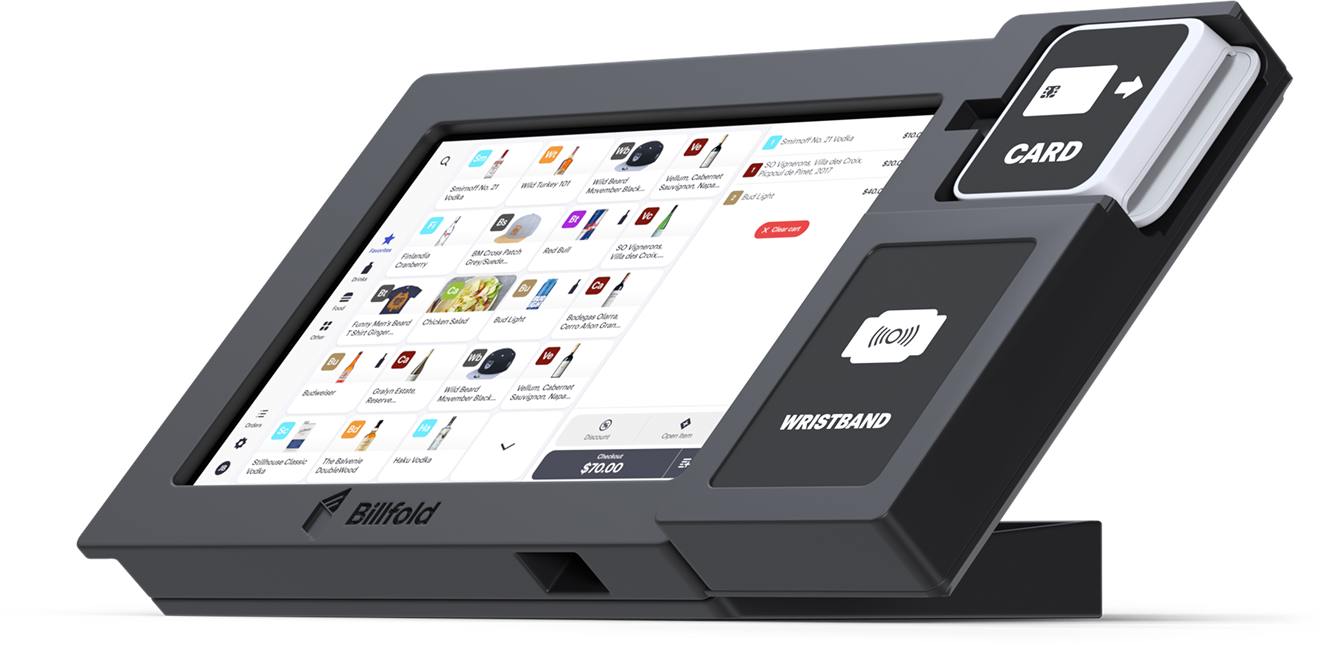How to Streamline Event Payments with RFID POS Systems

Key Takeaways
RFID cashless POS systems transform event operations through lightning-fast transactions, offline functionality, and comprehensive data insights.
- Global market expansion: RFID technology market reached $15.49 billion in 2024 and projected to grow at 11.68% annually through 2032
- Contactless payment surge: Global contactless transactions will reach $15.7 trillion by 2029, driven by event applications
- US market leadership: US contactless payment market projected to reach $1.5 trillion by 2024 with widespread merchant adoption
- Future-ready technology: Industry experts predict contactless payments will dominate event transactions within five years
Ready to revolutionize your event payments? RFID point of sale systems offer the fastest path to increased revenue and enhanced guest experiences.
Modern event organizers face mounting pressure to deliver seamless experiences while maximizing revenue potential. According to Juniper Research, contactless payment transactions will reach $15.7 trillion globally by 2029, with event and entertainment applications driving significant growth.
RFID cashless POS systems eliminate traditional payment bottlenecks by transforming how attendees interact with vendors, access venues, and make purchases. Radio Frequency Identification technology enables instant, contactless transactions through wearable devices like wristbands, creating seamless experiences that drive measurable business results.
What Makes RFID Cashless POS Systems Revolutionary for Events?
RFID point of sale technology represents a fundamental shift from traditional payment processing. Unlike conventional systems requiring network connectivity for each transaction, RFID cashless POS operates completely offline while maintaining enterprise-level security protocols.
The technology consists of three integrated components working together. RFID tags embedded in wearable devices store encrypted payment information and unique identifiers. Strategic placement of RFID readers at vendor locations captures transaction data through radio wave communication. Backend systems process payments, manage account balances, and generate comprehensive analytics about attendee spending patterns.
Event payment POS systems using RFID technology process transactions in milliseconds rather than the extended time periods required for traditional credit card authorization. This speed difference becomes critical during peak purchasing periods when every second directly impacts potential sales volume.
The global contactless payment adoption demonstrates this technology's viability across industries. Market research indicates that contactless payment adoption continues accelerating worldwide, with the US market leading implementation across retail and entertainment sectors.
How Do RFID Point of Sale Systems Transform Event Revenue?
Revenue optimization becomes possible when barriers to purchase disappear. Events implementing comprehensive RFID cashless POS solutions consistently report significant improvements in operational efficiency compared to traditional payment methods.
The speed advantages translate directly into sales opportunities. Vendors can serve substantially more customers during peak periods when transaction processing takes seconds rather than minutes. This efficiency proves particularly valuable at high-traffic events where queue length often determines whether attendees make purchases or walk away.
RFID systems eliminate hidden costs associated with cash handling, including security transportation, manual reconciliation, staff training on cash management, and theft prevention measures. Organizations implementing cashless solutions report measurable operational improvements after deployment.
Modern contactless POS systems provide real-time analytics that enable dynamic resource allocation during events. Organizers can monitor vendor performance, identify popular products, and track attendee movement patterns to optimize operations continuously.
Organizations considering RFID implementation should consult a comprehensive buyer's guide to understand all evaluation criteria before making vendor decisions.
What Are the Essential Components of Effective RFID Cashless POS Implementation?
Successful deployment requires careful attention to hardware selection, system integration, and operational processes. Events must choose components that support industry-standard protocols rather than proprietary formats limiting future flexibility.
Hardware infrastructure forms the foundation of reliable RFID point of sale operations. This includes strategically positioned readers throughout venue spaces, communication networks handling data transmission, and wearable devices designed for extended use in challenging event environments.
Wearable device selection impacts both functionality and attendee experience. Modern RFID wristbands integrate multiple payment methods within single devices, including prepaid balances, credit card linking, and mobile wallet integration. Durability becomes critical for multi-day festivals or outdoor events where devices face potential water exposure, temperature extremes, and physical stress.

Reader placement requires strategic planning to ensure comprehensive venue coverage without creating bottlenecks. High-traffic areas need multiple readers to handle peak transaction volumes, while specialized zones may require different configurations based on specific operational requirements.
Backend system capabilities determine whether integrated systems can work together effectively. Look for solutions supporting real-time data synchronization, webhooks, event-driven updates, and bi-directional data flows. Systems relying on periodic batch updates create timing issues and data inconsistencies.
Why Do Events Choose RFID Payment Systems Over Traditional Methods?
Operational Efficiency Advantages
Transaction speed improvements represent the most immediately visible benefit of RFID cashless POS implementation. Processing payments in seconds versus extended periods for traditional methods creates cascading effects throughout event operations.
Staff productivity increases when vendors can focus on customer service rather than payment processing complications. Automated transaction recording eliminates manual cash counting, change-making, and end-of-day reconciliation processes.
Inventory management becomes more precise with real-time sales tracking. Vendors can monitor stock levels continuously and receive automated alerts when popular items approach depletion, enabling proactive restocking decisions.
Financial Performance Benefits
Revenue per attendee increases consistently when purchase friction decreases. Events implementing comprehensive RFID point of sale systems report measurable improvements in financial performance compared to traditional payment methods.
Cash handling costs disappear entirely with cashless operations. Organizations eliminate expenses related to secure cash transport, deposit processing, variance reconciliation, and theft insurance coverage.
Payment processing efficiency improves with contactless POS systems due to bulk transaction processing capabilities and streamlined reconciliation procedures. Closed-loop systems particularly benefit from simplified financial management processes.
Customer Experience Enhancements
Attendee satisfaction improves when purchase processes become effortless. RFID cashless POS eliminates wallet searching, card fumbling, PIN entry, and receipt handling that slow traditional transactions.
Line lengths decrease significantly when transaction times drop from extended periods to seconds. Shorter queues create positive perception cycles where reduced wait times encourage more frequent purchases.
Budget control becomes easier when attendees preload funds onto RFID devices. This approach eliminates overspending concerns while providing transparent transaction tracking through mobile applications.
Modern RFID wristbands deliver enhanced guest experiences that extend far beyond payment processing to include access control and personalized interactions.

Data and Analytics Advantages
Real-time spending patterns provide unprecedented operational visibility. Event organizers can monitor vendor performance, identify popular products, and track attendee movement throughout venue spaces.
Post-event analysis reveals trends informing future planning decisions. Understanding peak purchasing times, preferred vendor locations, and demographic spending patterns enables optimized resource allocation.
Dynamic resource allocation becomes possible with live data feeds. Staff can be redirected to high-demand areas, vendor inventory adjusted based on real-time consumption, and operational bottlenecks addressed immediately.
How Can You Overcome Common RFID Implementation Challenges?
Technology integration challenges arise when existing systems lack compatibility with modern RFID point of sale platforms. Organizations should prioritize solutions with comprehensive API documentation, sandbox testing environments, and proven integration capabilities.
Staff training requirements vary based on system complexity and organizational readiness. Effective implementations include hands-on training sessions, detailed operational procedures, and ongoing support resources to ensure smooth transitions.
Cost considerations extend beyond initial hardware purchases to include ongoing subscription fees, payment processing charges, and maintenance expenses. Organizations typically achieve positive return on investment through increased operational efficiency and enhanced customer experiences.
Security concerns require robust protocols including advanced encryption, tokenization, and fraud detection capabilities. Modern RFID systems meet or exceed traditional payment security standards while providing additional authentication layers.
Network dependency misconceptions persist despite offline functionality being a core RFID advantage. Quality systems operate completely without internet connectivity by storing transaction data locally and synchronizing when connectivity resumes.
What Industry Trends Are Shaping the Future of Event Payment Systems?
The global RFID market reached $15.49 billion in 2024 and is projected to grow to $37.71 billion by 2032, with contactless payment applications driving significant expansion. This growth reflects fundamental shifts in consumer expectations and business operational requirements.
Integration with Internet of Things sensors creates opportunities for enhanced event management capabilities. RFID-enabled systems can communicate with environmental monitors, crowd density sensors, and facility management platforms to optimize overall event operations.
Artificial intelligence applications are emerging within contactless POS platforms to provide predictive analytics, fraud detection, and personalized attendee experiences. Machine learning algorithms analyze spending patterns to suggest optimal vendor placement and product offerings.
Biometric authentication integration represents the next evolution in secure contactless payments. Fingerprint and facial recognition capabilities combined with RFID technology promise even faster authentication while maintaining security standards.
Mobile wallet integration continues expanding as smartphone adoption increases globally. Industry analysts predict continued growth in contactless payment adoption across all demographic segments throughout the next decade.
How Do You Select the Right RFID Cashless POS Partner?
Vendor evaluation should focus on proven track records with events similar to your scale and complexity. Request detailed case studies, client references, and performance metrics from comparable implementations.
Technical capabilities assessment involves examining API documentation quality, real-time synchronization support, offline functionality reliability, and security protocol compliance. Avoid systems requiring custom coding for basic integrations or charging significant fees for API access.
Support infrastructure becomes critical during high-stakes live events. Partners should provide comprehensive staff training, detailed documentation, go-live support, and post-implementation optimization assistance.
Scalability considerations ensure systems can handle growth in attendance, vendor count, and transaction volume without performance degradation. Cloud-based architectures typically offer better scalability than on-premises solutions.
Integration flexibility allows connection with existing ticketing platforms, access control systems, inventory management tools, and analytics platforms. Proprietary systems limiting integration options should be avoided.
What Does a Successful RFID Implementation Timeline Look Like?
Planning phases should begin 3-6 months before event dates to allow adequate time for vendor selection, system configuration, staff training, and testing procedures. Rushed implementations increase the risk of operational issues during live events.
Hardware deployment requires careful coordination with venue logistics, power requirements, and network infrastructure. Reader placement testing ensures optimal coverage while avoiding interference with other electronic systems.
Staff training programs should include hands-on experience with actual hardware, troubleshooting procedures, customer service protocols, and escalation processes. Training typically requires dedicated time for thorough preparation.
Testing protocols must validate all system components under realistic conditions including peak transaction volumes, network interruptions, and hardware stress scenarios. Comprehensive testing prevents problems during actual events.
Go-live support includes on-site technical personnel for the initial implementation period. Experienced partners provide real-time monitoring, immediate issue resolution, and performance optimization during critical launch phases.

How Should You Measure Success and ROI?
Revenue metrics provide the clearest indicators of RFID cashless POS system effectiveness. Track per-attendee spending, transaction volume, and vendor sales compared to previous events using traditional payment methods.
Operational efficiency measurements include transaction processing times, queue lengths, staff productivity, and customer satisfaction scores. These metrics demonstrate operational improvements beyond financial performance.
Data quality assessments examine the accuracy and completeness of analytics generated by event payment POS systems. Quality data enables better decision-making for future events and vendor management.
Customer feedback collection through post-event surveys provides insights into attendee experiences with RFID systems. Understanding user satisfaction helps identify improvement opportunities and validates implementation success.
Long-term analysis should examine trends across multiple events to identify consistent patterns and optimization opportunities. Continuous improvement processes ensure systems deliver maximum value over time.
Frequently Asked Questions
How much do RFID cashless POS systems typically cost for events? Total costs vary based on attendee volume and system complexity, typically ranging from initial setup expenses to ongoing operational costs including software subscriptions and payment processing. Events should evaluate total cost of ownership including hardware, software, training, and support when making investment decisions.
Can RFID payment systems work without internet connectivity? Yes, robust RFID cashless POS systems operate completely offline by storing transaction data locally and synchronizing with central servers when connectivity resumes. This capability proves essential for outdoor events, remote locations, or venues with unreliable internet access where traditional payment methods would fail completely.
How secure are RFID transactions compared to traditional payment methods? Modern event payment POS systems use advanced encryption protocols, tokenization, and dynamic authentication codes to secure each transaction. These systems typically provide superior security compared to traditional magnetic stripe cards while processing transactions faster than chip-based alternatives.
What happens to unused balances on RFID wristbands after events? Most RFID point of sale systems provide automated refund processes for unused prepaid balances. Attendees can typically request refunds through mobile applications or dedicated refund stations. Some systems also support balance transfers to future events or conversion to venue credits.
How long does it take to implement RFID systems for large events? Implementation timelines typically require 3-6 months for comprehensive deployments including vendor selection, system configuration, hardware installation, staff training, and testing procedures. Rushed implementations within shorter timeframes increase operational risks and should be avoided when possible.
Why Should Your Next Event Use RFID Cashless POS Technology?
RFID cashless POS systems represent strategic investments that transform customer experiences while driving measurable business results. Organizations implementing these solutions position themselves for success in an increasingly digital economy where customer expectations continue rising.
The evidence supports adoption: faster transactions, measurable operational improvements, reduced costs, and valuable customer insights that traditional payment methods cannot match. As the global RFID market grows toward $37.71 billion by 2032, early adopters gain competitive advantages that become increasingly difficult for others to match.
Success requires careful vendor selection, comprehensive planning, and commitment to proper implementation processes. Organizations investing in proven systems with robust feature sets and strong support capabilities achieve the best results and fastest return on investment.
Modern event organizers need payment solutions that enhance experiences while providing operational insights. RFID technology delivers both through proven platforms that have transformed thousands of events worldwide.
Transform your event operations with Billfold's proven RFID cashless POS platform. Our comprehensive solution streamlines payments while providing the analytics and operational insights you need to maximize every event's potential.

